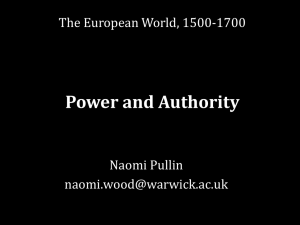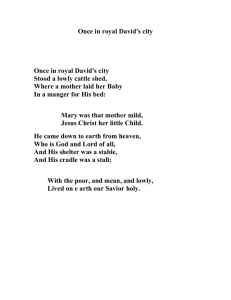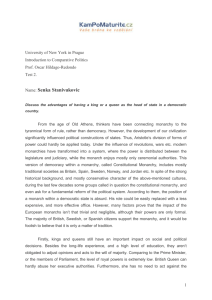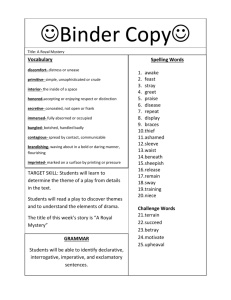Power and Authority
advertisement
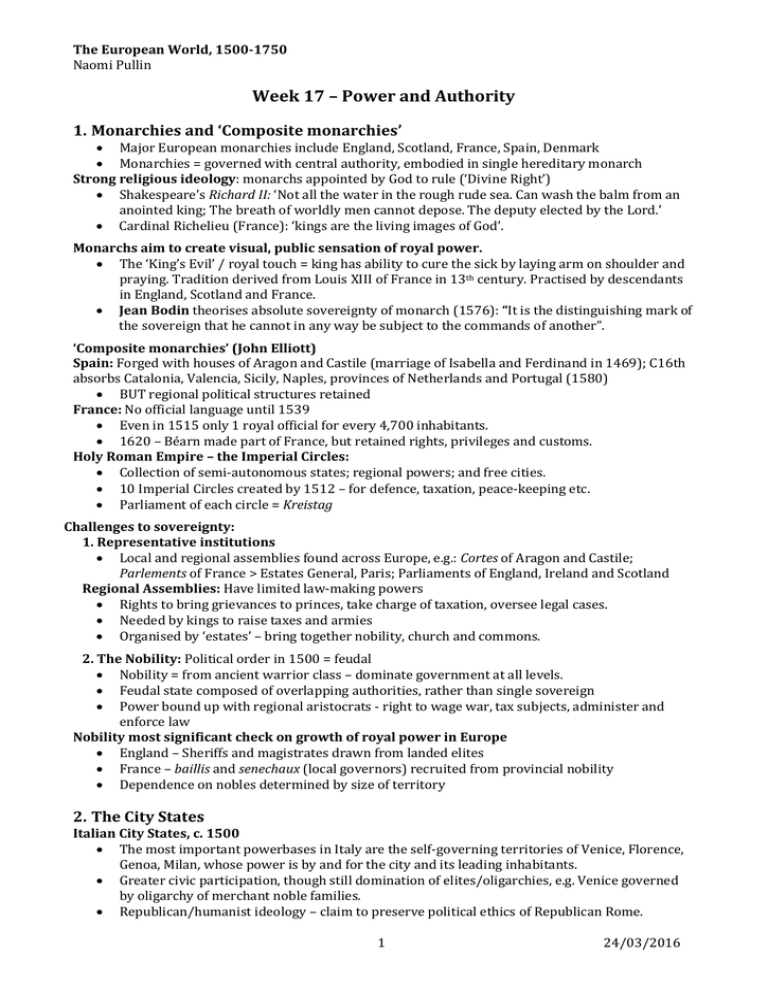
The European World, 1500-1750 Naomi Pullin Week 17 – Power and Authority 1. Monarchies and ‘Composite monarchies’ Major European monarchies include England, Scotland, France, Spain, Denmark Monarchies = governed with central authority, embodied in single hereditary monarch Strong religious ideology: monarchs appointed by God to rule (‘Divine Right’) Shakespeare’s Richard II: ‘Not all the water in the rough rude sea. Can wash the balm from an anointed king; The breath of worldly men cannot depose. The deputy elected by the Lord.’ Cardinal Richelieu (France): ‘kings are the living images of God’. Monarchs aim to create visual, public sensation of royal power. The ‘King’s Evil’ / royal touch = king has ability to cure the sick by laying arm on shoulder and praying. Tradition derived from Louis XIII of France in 13th century. Practised by descendants in England, Scotland and France. Jean Bodin theorises absolute sovereignty of monarch (1576): “It is the distinguishing mark of the sovereign that he cannot in any way be subject to the commands of another”. ‘Composite monarchies’ (John Elliott) Spain: Forged with houses of Aragon and Castile (marriage of Isabella and Ferdinand in 1469); C16th absorbs Catalonia, Valencia, Sicily, Naples, provinces of Netherlands and Portugal (1580) BUT regional political structures retained France: No official language until 1539 Even in 1515 only 1 royal official for every 4,700 inhabitants. 1620 – Béarn made part of France, but retained rights, privileges and customs. Holy Roman Empire – the Imperial Circles: Collection of semi-autonomous states; regional powers; and free cities. 10 Imperial Circles created by 1512 – for defence, taxation, peace-keeping etc. Parliament of each circle = Kreistag Challenges to sovereignty: 1. Representative institutions Local and regional assemblies found across Europe, e.g.: Cortes of Aragon and Castile; Parlements of France > Estates General, Paris; Parliaments of England, Ireland and Scotland Regional Assemblies: Have limited law-making powers Rights to bring grievances to princes, take charge of taxation, oversee legal cases. Needed by kings to raise taxes and armies Organised by ‘estates’ – bring together nobility, church and commons. 2. The Nobility: Political order in 1500 = feudal Nobility = from ancient warrior class – dominate government at all levels. Feudal state composed of overlapping authorities, rather than single sovereign Power bound up with regional aristocrats - right to wage war, tax subjects, administer and enforce law Nobility most significant check on growth of royal power in Europe England – Sheriffs and magistrates drawn from landed elites France – baillis and senechaux (local governors) recruited from provincial nobility Dependence on nobles determined by size of territory 2. The City States Italian City States, c. 1500 The most important powerbases in Italy are the self-governing territories of Venice, Florence, Genoa, Milan, whose power is by and for the city and its leading inhabitants. Greater civic participation, though still domination of elites/oligarchies, e.g. Venice governed by oligarchy of merchant noble families. Republican/humanist ideology – claim to preserve political ethics of Republican Rome. 1 24/03/2016 The European World, 1500-1750 Naomi Pullin Spread of humanism= influence of Italian civic writings over wider parts of Europe: Cities and republics beyond Italy Historians also see republics elsewhere in Europe, e.g. England: Patrick Collinson – ‘monarchical republic of Queen Elizabeth I’; Mark Goldie – C16th England ‘an unacknowledged Republic’ > ‘chief inhabitants’ of towns and cities closely involved in their governance. 3. Expansion of royal power in Europe and some challenges Conquest Competition between monarchs for territory – greatest source of conflict. Driven by better funded imperial armies and better technology Spain: Conquer Valencia, Catalonia, the Netherlands and Portugal in C16th, and Mexico and Peru Italian Wars 1494-1559: City states fall in face of French, Austrian and Spanish expansion; by 1559 – only Venice and San Marino retain independence Centralisation Meaning of concept ‘empire’ / ‘imperium’ = total dominion, absolute sovereignty, not territorial conquests. 1. Control of the Church Facilitated by Reformation, e.g. Thomas Cromwell (1533) in England: ‘this realme of England is an Empire ... governed by one supreme head and king having the dignity and royal estate of the imperial crown of the same, unto whom a body politic... be bounden and owe to bear next to God a natural and humble obedience’’ Occurs in Catholic as much as Protestant states: 1516 Concordat of Bologna – kings of France given right to nominate appointments of all bishops ; 1555 Holy Roman Empire states - adopt policy of ‘cuius region, eius religio’ – of him the region, of him the religion. 2. Expansion of court • Court expanded into a major centre of government: Before 1500 courts = highly mobile and not fixed; 1500-1750 = became permanent seats of gov. administration • Emergence of new class of royal official and bureaucracy, e.g. during Henry VIII’s reign in England - Thomas More and Thomas Cromwell • Spanish Court: 1561 - permanently established in Madrid becoming lynchpin of central government. 3. Legal and Political uniformity • Expansion of control over the regions to challenge representative institutions and nobility • Europe 1400 had 1,000 independent polities; by 1700 less than 350. • England under Henry VIII, 1536-41: Wales incorporated into full union with England; Ireland brought under English control - ‘surrender and regrant’ forced landowners to submit control of lands to Crown • Spain under Philip IV and Count Olivares, 1620s-40s: ‘one king, one law and one coinage’ across Spanish domains; 1632 - control of cities taken from Castilian Cortes; New military policy called ‘Union of Arms’ • Centralisation in France under Cardinal Richelieu Louis XIII from 1610s: Dilute power of nobility with royal councils and provincial officials called Intendants; can raise troops, administer justice, raise and collect taxes; Growth of bureaucracy: 1515 1 royal official for every 4,700 inhabitants; 1665 1 royal official for every 380 inhabitants Tensions between official institutions and state-building Centralisation leads to rebellion from nobles, regional rulers, and scholars 1590s: Irish Rebellion against English Rule and ‘Plantation’ policy (Nine Years’ War); Dutch Revolt against Philip II of Spain > creation of Dutch Republic 1640s: Rebellions in Scotland and Ireland against religious uniformity > Civil War in England and execution of Charles I; Rebellions in Naples, Catalonia and Portugal against Philip IV of Spain and Count of Olivares > Portuguese independence. 2 24/03/2016
